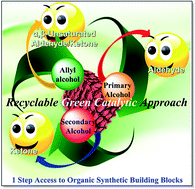Strongly coupled Mn3O4–porous organic polymer hybrid: a robust, durable and potential nanocatalyst for alcohol oxidation reactions†
Abstract
Herein we describe a novel strategy for noble-metal-free Mn3O4@POP (porous organic polymer) hybrid synthesis by encapsulation of Mn3O4-NP in the interior cavity of a porous organic polymer which exhibited enhanced catalytic activity and stability for oxidation of diverse activated and nonactivated alcohols relative to the conventional catalysts to demonstrate the benefits of such a nanoarchitecture in heterogeneous nanocatalysis. The use of a non precious catalyst, tremendous recyclability (upto 15 catalytic runs) and exceptional stability make our system innovative in nature, addressing all the profound challenges in the noble-metal-free heterogeneous catalysts development community.


 Please wait while we load your content...
Please wait while we load your content...